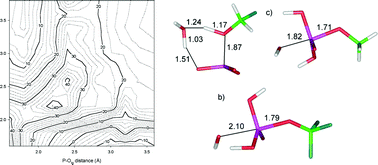The effect of leaving group on mechanistic preference in phosphate monoester hydrolysis†
Abstract
We present 2-dimensional potential energy surfaces and optimised transition states (TS) for

* Corresponding authors
a Department of Organic Chemistry, Arrhenius Laboratory, Stockholm University, S-10691 Stockholm, Sweden
b
School of Chemistry, University of Birmingham, Edgbaston, Birmingham, UK
E-mail:
j.wilkie@bham.ac.uk
Fax: +44 (0)121 414 4403
Tel: +44 (0)121 414 7189
We present 2-dimensional potential energy surfaces and optimised transition states (TS) for

 Please wait while we load your content...
Something went wrong. Try again?
Please wait while we load your content...
Something went wrong. Try again?
S. C. L. Kamerlin and J. Wilkie, Org. Biomol. Chem., 2011, 9, 5394 DOI: 10.1039/C0OB01210F
To request permission to reproduce material from this article, please go to the Copyright Clearance Center request page.
If you are an author contributing to an RSC publication, you do not need to request permission provided correct acknowledgement is given.
If you are the author of this article, you do not need to request permission to reproduce figures and diagrams provided correct acknowledgement is given. If you want to reproduce the whole article in a third-party publication (excluding your thesis/dissertation for which permission is not required) please go to the Copyright Clearance Center request page.
Read more about how to correctly acknowledge RSC content.
 Fetching data from CrossRef.
Fetching data from CrossRef.
This may take some time to load.
Loading related content
